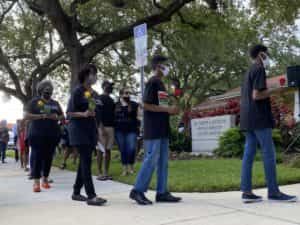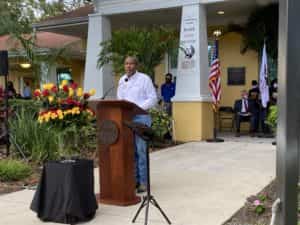Thrive
Duality of Black joy and Black pain collide at St. Petersburg’s Juneteenth celebration

St. Petersburg’s official recognition and celebration of Juneteenth started with a demonstration. Elected officials and community members walked out of the Carter G. Woodson African American Museum and built a bouquet.
Red and yellow roses were added one by one, each representing the name of a Black man or woman, a victim of police or vigilante violence over the last decade. Each of the names was read aloud, in an incomplete list so long that it took more than three full minutes to reach the bottom.
The somber demonstration was followed by prayer, the Negro National Anthem, spoken word poetry, speeches, dance and jubilant celebration. In many ways, the celebration was indicative of Juneteenth itself.
 Juneteenth is a celebration to commemorate the emancipation of enslaved people in the United States. But it also holds within it a duality of delayed justice. The holiday marks the emancipation of slaves in Galveston, Texas on June 19, 1865, two and a half years after the Emancipation Proclamation was signed by Abraham Lincoln January 1, 1863.
Juneteenth is a celebration to commemorate the emancipation of enslaved people in the United States. But it also holds within it a duality of delayed justice. The holiday marks the emancipation of slaves in Galveston, Texas on June 19, 1865, two and a half years after the Emancipation Proclamation was signed by Abraham Lincoln January 1, 1863.
The lesser-known holiday has gained notoriety this year, as it once did in 1968, after the assassination of Martin Luther King Jr, and again in 1992, following the acquittal of the police officers who beat Rodney King and gave rise to chaos and civil unrest that became known as the L.A. Riots of 1992.
After nearly a month of sustained worldwide protests sparked by the death of George Floyd while in the custody of Minneapolis police, racial equity, police brutality and the question of freedom are again at the forefront of the American consciousness. A consciousness and a struggle encapsulated in one word, written on the t-shirts of Carter G. Woodson staff and attendees: “Free-ish.”
“From the very start, complete emancipation has been a work in progress,” said Pinellas County Commissioner Ken Welch. “While much progress has been made, it is self-evident that in many facets of the African American experience, the struggle continues. The struggle for economic equity, for housing, for healthcare access, for justice reform and for civil rights.
“Though we’ve made strides locally, the murder of George Floyd, Breonna Taylor and Rayshard Brooks by the police, the murder of Ahmaud Arbery by street vigilantes, and the streak of young African American men hanging from trees across our nation, classified as suicides, reminds us of the dangers we still face on the streets of America simply because of the color of our skin,” Welch said. “The work, the protest, the struggle continues.”
He lamented the legal battle surrounding Amendment 4, the ballot measure that granted returning citizens the right to vote following the completion of their prison sentence. He lamented the disparate health outcomes related to the COVID-19 pandemic. He cited the statistics reported by the Pinellas County Department of Health, which show that while African Americans make up just 10 percent of the population of Pinellas County, they account for 25 percent of COVID-19 cases.
“The numbers reported today will be another record high in Pinellas County and in Hillsborough,” Welch warned. “This is serious.”
Welch’s sentiments were echoed by Terri Lipsey Scott,, Executive Director of the Carter G. Woodson African American Museum, Rep. Charlie Crist and State Senator Darryl Rouson. Each of the speakers agreed that there was much work to do.
“Despite injustice, Blacks have continued to find a way to overcome,” said Scott. “We have continued to move forward and excel despite the knees on our necks in workplaces, in or communities, and in our daily walk. As a people we have found strength despite the countless obstacles, to celebrate.
“We celebrate the victory of crossing seas to reach this place called America, we celebrate the lives of those who endured and those who succumbed to the master’s whip and its their shoulders on which we stand. We celebrate the day it was determined that we were no longer enslaved people but free in these United States.”
Crist spoke to the duality of the day.
“Juneteenth is a day of reverence for the most painful, saddest chapter in American history,” Crist explained. “But also a celebration, that speaks to good overcoming evil, of the right of wrongs, of a new chapter and a continual rebirth of our nation, as we seek a more perfect union.
“Juneteenth carries more meaning this year than most, when millions across our country stand in defiance of police brutality and the murder of unarmed black men and women, chanting in unison, ‘I can’t breathe,’ it is again a time for change, a time for justice, a time for renewal.”
He also spoke of the work ahead for members of Congress, work that includes voting on a federal police reform bill that would ban chokeholds and no knock warrants. The bill would make body cameras mandatory, and create a computer system to track law enforcement officers nationally. Crist simultaneously called for a break from an increasingly militarized police force and a return to community policing.
Rouson called on the community to continue the fight, and to create change through civic action while leaders and corporations are listening.
“We must come forward with a platform, a plan, the agenda to make sure that they’re hearing what we’re saying,” he explained.
“The riot is the language of the unheard and what is it that America has failed to hear? They’ve failed to hear a cry for equal application of the law, they’ve failed to hear a cry that due process once arrested or accused should take place in a courtroom, not a parking lot. They failed to hear that man’s inhumanity to man has caused poverty, economic injustice, environmental injustice.
“This is the time now, we must walk through this portal of opportunity with greatness on our minds. I’m proud to stand here and say that Black Lives Matter … We have much work to do, the time is running out, the motor is cranked up and we’re moving down the highway of destiny.”
The celebration was punctuated by a newly painted street mural, directly in front of the Dr. Carter G. Woodson Museum, just off of 22nd St. S, known as the Deuces.
The “Black Lives Matter” mural includes work from 16 different local St. Petersburg artists, each of whom took one letter as their own. The idea for the mural spread to cities across the nation after Washington, D.C. Mayor Muriel Bowser commissioned one on the street leading to the White House.
“A couple of my fellow mayors have done this in their cities and I think there’s never a bad time or place to loudly and proudly declare in bold letters what matters,” St. Petersburg Mayor Rick Kriseman said of the mural.
Scott explained that she reached out to Council member Lisa Wheeler Bowman about the idea, who obtained approval and connected Scott with the Arts Alliance and SHINE Mural Festival organizer Jenee Priebe. The mural was completed in less than a day and a half.
Scott intimated that she had received some criticism for the placement of the mural in front of the museum, rather than in highly trafficked areas of downtown St. Petersburg or along Beach Drive.
“To those who suggested that this extraordinary work of art has no place in this space, in this community, I say to you: when Black lives mattered nowhere else in this city, they mattered here.”











Ericka Guy
June 19, 2020at4:04 pm
I think it’s imperative to place a mural on Central Avenue, the place where St. Petersburg was famous for its green benches that black people were forbidden from sitting.